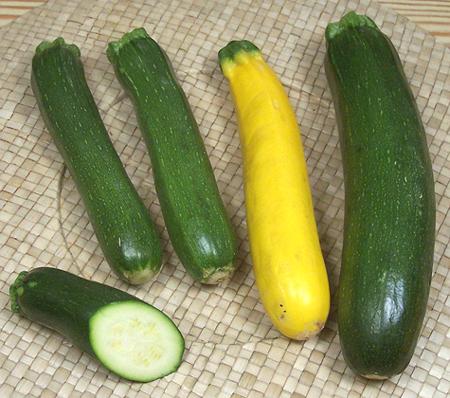 [Italian squash; Courgette (UK); Cocozelle (Italy); C. pepo]
[Italian squash; Courgette (UK); Cocozelle (Italy); C. pepo]
This is by far the most popular squash in North America, and even in England it is eclipsing the Vegetable Marrow. Zucchini can be eaten raw in salads, or cooked in many ways.
Seeds for this summer squash came from Italy to the Italian farming communities of California. Growers here marketed it as Zucchini ("little squash") and it became popular in trend setting Los Angeles restaurants. From there it spread to the rest of the world and "Zucchini" has pretty much replaced the original name, Cocozelle - except for the British who insist on calling it a Courgette.
Zucchini now comes in a variety of sizes, shapes (including spherical) and various shades of green and yellow. As is so common with vegetables, the yellow varieties have a blander flavor than the green, and I don't use them.
Pictured are very young squash, much in demand for Mediterranean and Middle Eastern cooking, a yellow variety and a medium size. Left to grow they could all have become the monster zeppelins found in back yard gardens. The small are 6-1/2 inches long, 1-1/8 inch diameter and weigh a shade over 3 ounces. The medium one was 8-1/2 inches long, 1-3/4 inches in diameter and weighed 9-1/2 ounces. They shouldn't be allowed to get much bigger unless you intend to stuff them because flavor and texture will suffer. Also, if you pick them young you don't end up with that ton of zucchini you try to give away every year.
More on Squash.
In the Mediterranean and Middle East regions, Zucchinis are often stuffed, after removing the seed mass. In the Americas and most of Europe, they are more commonly cooked as slices with the seed mass intact.
Raw Zucchini can present some risk, but this is unlikely with commercial produce or garden zucchini from commercial seeds. Some zucchini, especially wild zucchini, contain dangerous amounts of cucurbitacins, which are toxic, but such zucchini will be very bitter. The rule is simple, if the zucchini is bitter, toss it. There is also a risk of gas from fermentation of soluble fiber in the gut, but this is rather unlikely in the quantities raw zucchini is normally eaten, usually in salads.
sq_zuchz 220716 - www.clovegarden.com